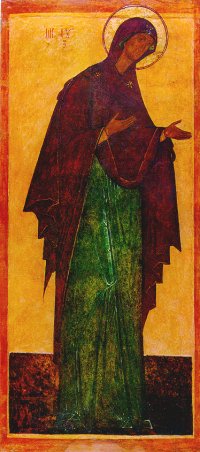
Pskov School, 16th century.
The Pskov Museum of History and Architecture, 145 x 65 cm.

 The 16th-century Pskov Virgin from the Deesis is an excellent example of not only Pskov school of icon painting, but also of the changes that began to occur in icon painting in general around the 15th-16th centuries.
The 16th-century Pskov Virgin from the Deesis is an excellent example of not only Pskov school of icon painting, but also of the changes that began to occur in icon painting in general around the 15th-16th centuries.
Restored between1969 and 1970, the icon is now housed in the Pskov Museum of History and Architecture. Due to the proximity of both towns, the Pskov school ran parallel in time to that of Novgorod. The Pskov school shared with Novogorod a number of the most popular topics but also managed to develop its own tradition. Further examination of the Virgin from the Deesis row shows important features of that tradition.
Unlike most Pskov icons, the Virgin from the Deesis was painted with tempera on canvas and gesso ground applied to a lime board, not to pine. In the Pskov tradition, the gesso ground is never fully smoothed out, leaving a slightly rough surface for painting (Yamshchikov, 164). This method of applying the ground, coupled with the tendency of the time to make the images more "real," results in an icon that appears less immaterial (supernatural) to the worshiper or viewer. Later, in the 17th century, this technique will contradict the original theological purpose of icon painting, that is, the iconographers' attempts to create spiritual representations, and not idols, of the saints. Early icons were originally painted to look very different than real human figures to separate them from other, representational paintings. The Pskov style of rough gesso ground, the absence of a shiny finish and the eventual move toward a more realistic depiction of the figures seem to contradict the originally intended dematerialized and supernatural portrayal of the subjects.
In the 15th and 16th centuries, iconographers moved to more "realistic" depictions of the subjects, leaving behind the flatness and one-dimensionality of previous centuries. The hands and the face of the Virgin provide some evidence of the transition towards "realistic" interpretations. The face, although typically somber and serious, is not as flat as in earlier icons. Both the hands and face are rendered using volume and shadowing, as seen around the chin and on the palm of the left hand. The eyes of the Virgin are not directed at the observer but rather off to the side, as if she were looking at something or someone outside the frame.
The most obvious characteristic allowing us to attribute this icon to the Pskov school is the color selection. Pskov icons are known for three distinguishing colors: a deep crimson-like red, a bright yellow, and particularly a deep, dark, emerald green. All of these have been incorporated generously into this representation of the Virgin. The Virgin's skirt has been painted with Pskov green, while her cloak is red. It is adorned with star-like markings at the shoulder, possibly signifying the light of God. The Virgin's head is encircled with a halo outlined with Pskov red. Offsetting the figure of the Virgin is the yellow background. Pskov artists preferred the yellow to the Byzantine or Novgorodian gold leaf. This yellow, in contrast to the dark colors of the Virgin, makes the icon appear much brighter. The bottom quarter of the background had been painted with a brownish red. This creates a sense of three-dimensionality, giving the feeling that the Virgin is standing on a floor with the yellow wall behind her.
Another distinguishing characteristic of the Pskov school is the depiction of the subject's movements. Emphasis is put on vigorous yet uncompleted movements or dynamic actions. Here, the Virgin is seen standing sideways, with her gaze directed out of the boundary of the painting and with her hands held out as if beckoning someone to come to her. One might be able to imagine her talking to a worshiper or walking in the direction of her gaze. It is not surprising that this icon does not show characteristic Pskov dynamic movements because all icons found in the Deesis row are much more static.
The Pskov school is also known for two other peculiar features. Free brush strokes can often be noticed in Pskov icons (Yamshchikov, 164). This is not as evident in this Virgin from the Deesis as in other Pskov icons. Pskov iconographers are also known for their intentional deformation of lines and planes, specifically using straight lines to depict curves. Such a deformation of lines can be noticed in the rendering of the Virgin's cloak, in which the curves are indicated not by long, sweeping, rounded lines, but by short and straight ones (Yamshchikov, 165). [L.O.]
[Source: Yamshchikov].
